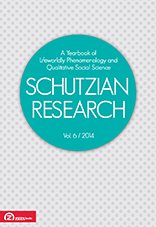Husserl’s Phenomenology in America (USA): The Human Science Legacy of Wilbur Marshall Urban and the Yale School of Communicology
Husserl’s Phenomenology in America (USA): The Human Science Legacy of Wilbur Marshall Urban and the Yale School of Communicology
Author(s): Richard L. LaniganSubject(s): Philosophy
Published by: Zeta Books
Keywords: Hubert Alexander; Communicology; Symbolism; Language; Yale University
Summary/Abstract: Edmund Husserl gave his famous London Lectures (in German) in June 1922 where he says his purpose is to explain “transcendental sociological [intersubjective] phenomenology having reference to a manifest multiplicity of conscious subjects communicating with one another”. This effective definition of semiotic phenomenology as Communicology was reported in English (1923) by Charles K. Ogden and I. A. Richards in the first book on the topic titled The Meaning of Meaning. This groundwork was in full development by 1939 with the first detailed use of Husserl’s phenomenology to explicate human communication, i.e., the publication of Wilbur Marshal Urban’s Language and Reality. My paper addresses Urban’s use of Husserl’s philosophy to both explicate the phenomenological method and to explore the constitutive elements of human communication and culture. Urban makes use of the work on language and culture by his famous colleagues at Yale University (USA): Edward Sapir (the linguist), Benjamin Lee Whorf (Sapir’s graduate student), and Ernst Cassirer. My own teacher at the University of New Mexico (USA) was Hubert Griggs Alexander, a doctoral student under Urban and a classmate of Whorf. The interdisciplinary focus on Culture and Communicology by Professors Cassirer, Sapir, Urban, and their doctoral students, Alexander and Whorf are collectively known as the “Yale School of Communicology.” Typical empirical examples of theoretical points are provided in the footnotes.
Journal: Schutzian Research. A Yearbook of Lifeworldly Phenomenology and Qualitative Social Science
- Issue Year: 2011
- Issue No: Volume 3
- Page Range: 203-217
- Page Count: 15
- Language: English
- Content File-PDF

